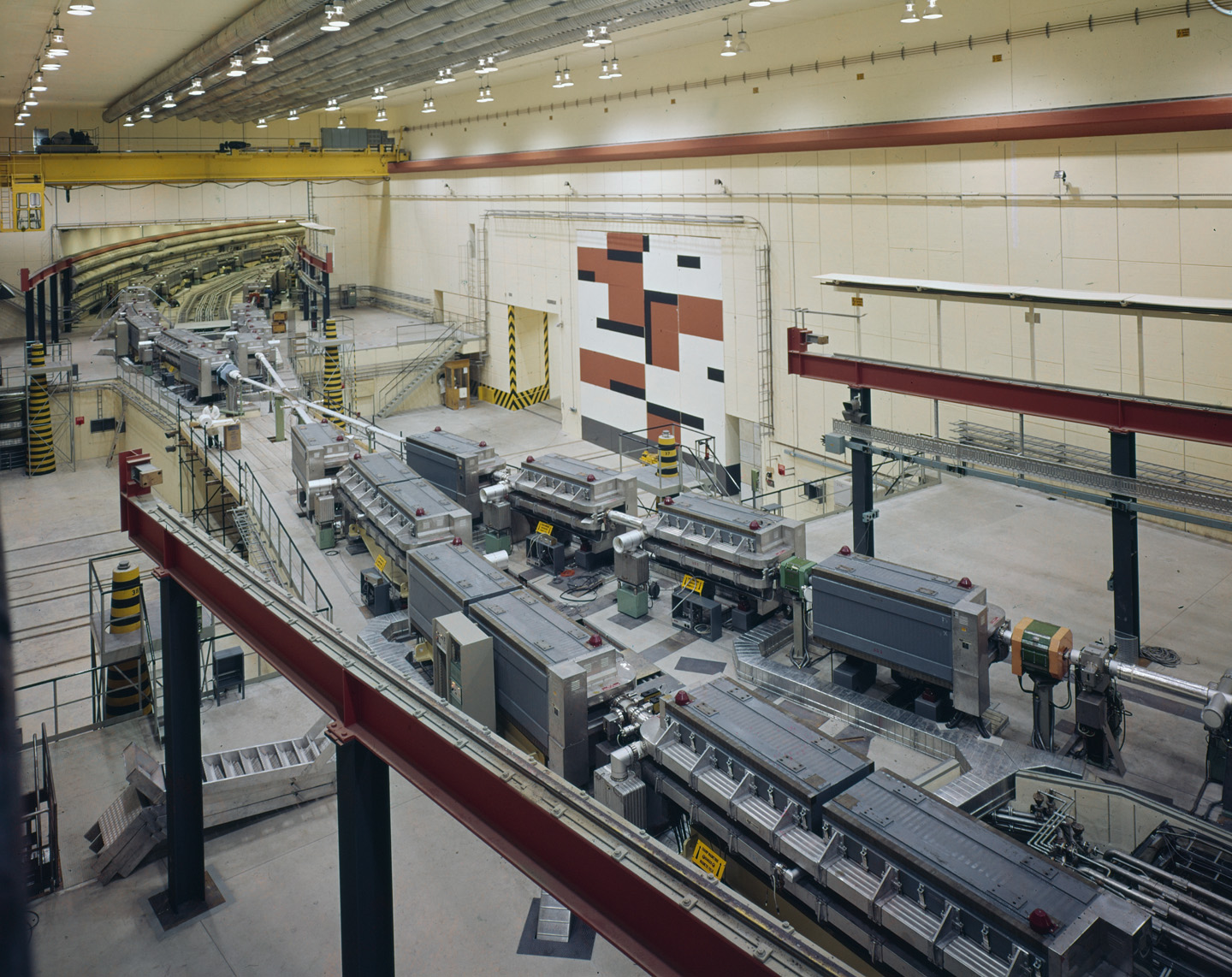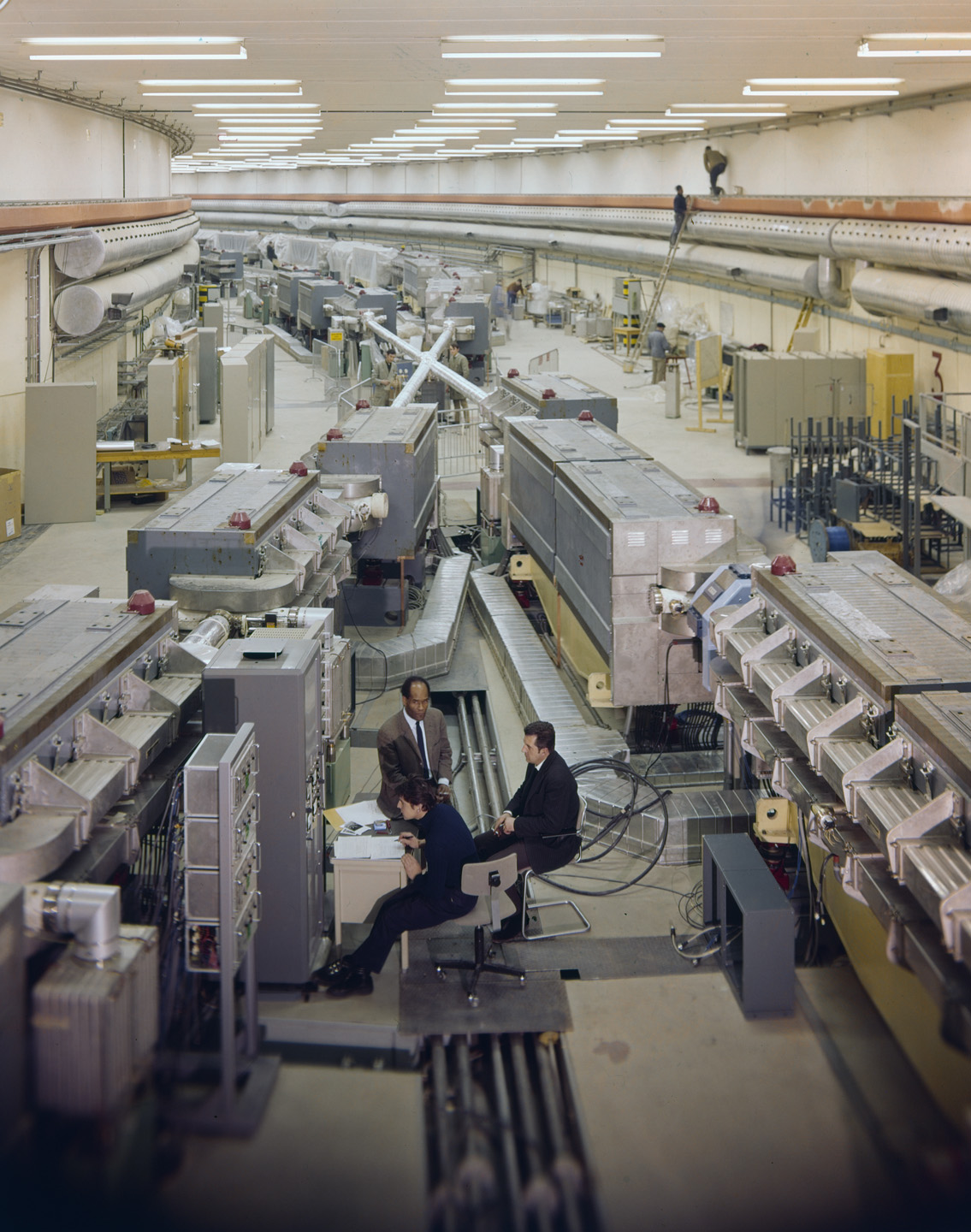Intersecting Storage Rings on:
[Wikipedia]
[Google]
[Amazon]
 The ISR (standing for "Intersecting Storage Rings") was a
The ISR (standing for "Intersecting Storage Rings") was a
 The idea of colliding beams was first conceived by a group at Midwestern Universities Research Association (MURA) in the
The idea of colliding beams was first conceived by a group at Midwestern Universities Research Association (MURA) in the
 The accelerator was made up of two magnetic rings (located in France), each with a circumference of 942m. The rings interlaced together such that they would meet at eight intersecting regions for colliding proton beams. The 28 GeV proton beams would come from the CERN Proton Synchrotron (CPS) located about 200 meters away (In Switzerland)
The accelerator was made up of two magnetic rings (located in France), each with a circumference of 942m. The rings interlaced together such that they would meet at eight intersecting regions for colliding proton beams. The 28 GeV proton beams would come from the CERN Proton Synchrotron (CPS) located about 200 meters away (In Switzerland)

ISR startup
Early history of the ISR
Picture of the ISR from above
– The large earthen ring with circular roads inside and outside. {{Coord, 46, 14, 05, N, 6, 02, 35, E, region:CH-GE_type:landmark_source:kolossus-dewiki, display=title CERN accelerators Particle physics facilities CERN CERN experiments CERN facilities
 The ISR (standing for "Intersecting Storage Rings") was a
The ISR (standing for "Intersecting Storage Rings") was a particle accelerator
A particle accelerator is a machine that uses electromagnetic fields to propel electric charge, charged particles to very high speeds and energies, and to contain them in well-defined particle beam, beams.
Large accelerators are used for fun ...
at CERN. It was the world's first hadron
In particle physics, a hadron (; grc, ἁδρός, hadrós; "stout, thick") is a composite subatomic particle made of two or more quarks held together by the strong interaction. They are analogous to molecules that are held together by the ele ...
collider, and ran from 1971 to 1984, with a maximum center of mass energy
In physics, energy (from Ancient Greek: ἐνέργεια, ''enérgeia'', “activity”) is the quantitative property that is transferred to a body or to a physical system, recognizable in the performance of work and in the form of hea ...
of 62 GeV GEV may refer to:
* ''G.E.V.'' (board game), a tabletop game by Steve Jackson Games
* Ashe County Airport, in North Carolina, United States
* Gällivare Lapland Airport, in Sweden
* Generalized extreme value distribution
* Gev Sella, Israeli-South ...
. From its initial startup, the collider itself had the capability to produce particles like the J/ψ and the upsilon
Upsilon (, ; uppercase Υ, lowercase υ; el, ''ýpsilon'' ) or ypsilon is the 20th letter of the Greek alphabet. In the system of Greek numerals, grc, Υʹ, label=none has a value of 400. It is derived from the Phoenician waw .
Ety ...
, as well as observable jet structure; however, the particle detector
In experimental and applied particle physics, nuclear physics, and nuclear engineering, a particle detector, also known as a radiation detector, is a device used to detect, track, and/or identify ionizing particles, such as those produced by ...
experiments were not configured to observe events with large momentum
In Newtonian mechanics, momentum (more specifically linear momentum or translational momentum) is the product of the mass and velocity of an object. It is a vector quantity, possessing a magnitude and a direction. If is an object's mass ...
transverse to the beamline, leaving these discoveries to be made at other experiments in the mid-1970s. Nevertheless, the construction of the ISR involved many advances in accelerator physics, including the first use of stochastic cooling, and it held the record for luminosity
Luminosity is an absolute measure of radiated electromagnetic power (light), the radiant power emitted by a light-emitting object over time. In astronomy, luminosity is the total amount of electromagnetic energy emitted per unit of time by a s ...
at a hadron collider until surpassed by the Tevatron
The Tevatron was a circular particle accelerator (active until 2011) in the United States, at the Fermi National Accelerator Laboratory (also known as ''Fermilab''), east of Batavia, Illinois, and is the second highest energy particle collider ...
in 2004.
History
The ISR was proposed in 1964 for conducting the head-on proton-proton collisions at a beam energy of 28 GeV; to the study of the new particles created in such collisions. The project was approved within a year. The idea of colliding beams was first conceived by a group at Midwestern Universities Research Association (MURA) in the
The idea of colliding beams was first conceived by a group at Midwestern Universities Research Association (MURA) in the United States
The United States of America (U.S.A. or USA), commonly known as the United States (U.S. or US) or America, is a country primarily located in North America. It consists of 50 U.S. state, states, a Washington, D.C., federal district, five ma ...
, as a way to have collisions at an increased center of mass energy. The MURA group also invented radiofrequency (RF) stacking technique to accumulate the proton beams of sufficient intensity. CERN Council looked into this novel idea in 1957, and an Accelerator Research (AR) group was established to look into the possibilities of having such a facility. AR studied the two-way fixed-field alternating gradient (FFAG) accelerator for plasma acceleration and for an electron collider. In 1960 when the construction of the Proton Synchrotron
The Proton Synchrotron (PS, sometimes also referred to as CPS) is a particle accelerator at CERN. It is CERN's first synchrotron, beginning its operation in 1959. For a brief period the PS was the world's highest energy particle accelerator. It ...
was completed, the AR group focussed on a proton-proton collider. To check the feasibility and yield of the RF stacking method, the CERN Electron Storage and Accumulation Ring (CESAR) on a smaller scale compared to ISR, was proposed in 1960 and successfully tested by 1964; followed by the official proposal of ISR in the same year, when the AR group presented the technical design report.
In 1971 itself, detectors were set up by 12 experimental teams at five intersecting points of ISR.
The combination of the CERN Proton Synchrotron (CPS) and ISR also enabled the study of collisions using particles other than the proton, such as the deuteron, alpha particles
Alpha particles, also called alpha rays or alpha radiation, consist of two protons and two neutrons bound together into a particle identical to a helium-4 nucleus. They are generally produced in the process of alpha decay, but may also be produce ...
, and antiprotons.
The initial goal and motivation for ISR was the following.
# Finding the proton-proton cross-section for 23–54 GeV energy in the center of mass frame.
# Study of the elastic proton-proton scattering.
# Obtaining production spectra of particles like pions and kaons.
# Search for new particles.
During the end stages of ISR, the beam energies were hiked up to a maximum value of 31.4 GeV.
Accelerator
 The accelerator was made up of two magnetic rings (located in France), each with a circumference of 942m. The rings interlaced together such that they would meet at eight intersecting regions for colliding proton beams. The 28 GeV proton beams would come from the CERN Proton Synchrotron (CPS) located about 200 meters away (In Switzerland)
The accelerator was made up of two magnetic rings (located in France), each with a circumference of 942m. The rings interlaced together such that they would meet at eight intersecting regions for colliding proton beams. The 28 GeV proton beams would come from the CERN Proton Synchrotron (CPS) located about 200 meters away (In Switzerland)
Major leaps in accelerator technology
RF stacking
CERN Electron Storage and Accumulation Ring (CESAR) and later ISR were among the first colliders to utilize the RF beam stacking method to increase intensity. In the previous years, the construction of hadron colliders was avoided as it appeared to be unfruitful due to the unavailability of any stacking method. Since ISR, every other collider has utilized the RF stacking method.
Schottky noise and stochastic beam cooling
Schottky noise is a signal generated by a finite number of randomly distributed particles in a beam. In 1972 Wolfgang Schnell found the longitudinal and transverse Schottky noise signals at ISR. This made it evident thatstochastic
Stochastic (, ) refers to the property of being well described by a random probability distribution. Although stochasticity and randomness are distinct in that the former refers to a modeling approach and the latter refers to phenomena themselve ...
beam damping was possible. And brought up a new window for non-invasive beam diagnostics and the need to have an active cooling system for reducing the size and momentum spread of the beam.
The Schottky signals gave a precise description of how the density of the beam stack varied with betatron frequency. After demonstrating the damping of betatron oscillations, stochastic cooling of the antiprotons beams was widely used to enhance luminosities
Luminosity is an absolute measure of radiated electromagnetic power (light), the radiant power emitted by a light-emitting object over time. In astronomy, luminosity is the total amount of electromagnetic energy emitted per unit of time by a st ...
in proton-antiproton collisions. After ISR, the proton-antiproton collider at Super Proton Synchrotron employed the same technique for increasing luminosities, so did the other colliders such as Tevatron
The Tevatron was a circular particle accelerator (active until 2011) in the United States, at the Fermi National Accelerator Laboratory (also known as ''Fermilab''), east of Batavia, Illinois, and is the second highest energy particle collider ...
.
Thin-walled vacuum chambers
ISR group designed and set-up very large thin-walledvacuum chambers
A vacuum is a space devoid of matter. The word is derived from the Latin adjective ''vacuus'' for "vacant" or "void". An approximation to such vacuum is a region with a gaseous pressure much less than atmospheric pressure. Physicists often dis ...
at the intersecting points where detectors were set up. These were made up of tin and titanium
Titanium is a chemical element with the Symbol (chemistry), symbol Ti and atomic number 22. Found in nature only as an oxide, it can be reduced to produce a lustrous transition metal with a silver color, low density, and high strength, resista ...
and inspired the future vacuum chambers.
Detector magnets
The superconducting solenoid installed at Intersection-1, the Open Axial Field Magnet installed at Intersection-8 and an Air-cored Toroid at Intersection-6, were state-of-the-art magnetic detector systems developed by ISR teams. Almost all collider detectors are now based on larger and improved versions of basic principles of magnetic detectors put forth by ISR.See also
*Timeline of particle discoveries
This is a timeline of subatomic particle discoveries, including all particles thus far discovered which appear to be elementary (that is, indivisible) given the best available evidence. It also includes the discovery of composite particles and ...
*Roman pot The Roman pot is the name of a technique (and of the relevant device) used in accelerator physics. Named after its implementation by the CERN-Rome collaboration in the early 1970s, it is an important tool to measure the total cross section of two p ...
References
External links
ISR startup
Early history of the ISR
Picture of the ISR from above
– The large earthen ring with circular roads inside and outside. {{Coord, 46, 14, 05, N, 6, 02, 35, E, region:CH-GE_type:landmark_source:kolossus-dewiki, display=title CERN accelerators Particle physics facilities CERN CERN experiments CERN facilities